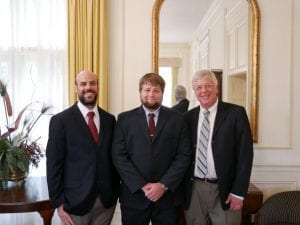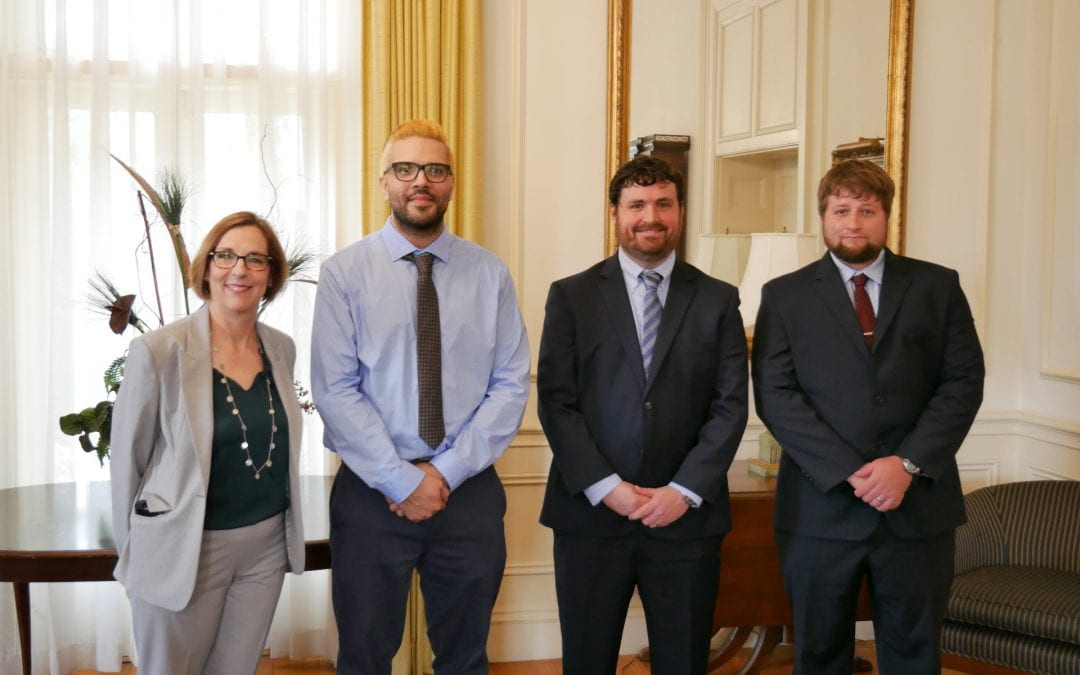
STEM Outstanding Dissertation Award Recipient Logan Wiest with his faculty mentor Steve Driese and Graduate Program Director Dan Peppe
On May 1, I had the privilege of helping recognize our 2019 Outstanding Graduate Students. Six students received Outstanding Graduate Instructor Awards and three students received Outstanding Dissertation Awards. I asked each of the students to speak about their graduate journey as well as a faculty member (either graduate program director or faculty mentor) to speak about the research and teaching success of each student.
I was prepared to hear about the excellent teaching records of the students. I was prepared to hear about their impressive research agendas. I was prepared for the glowing comments given by their doctoral advisors and graduate program directors.
I was not prepared, however, for the powerful student testimonies. Today I am so pleased to share one of these stories with you: Logan Wiest, an August 2018 doctoral graduate from Geosciences. His dissertation was nominated for the outstanding award by his department, Geosciences, and selected by STEM Graduate Program Directors as the 2019 STEM Outstanding Dissertation. May his story encourage you as much as his research impresses you.
Logan Wiest’s Story:
Growing up I never really pictured myself going to college. From a young age I started working various construction-type jobs and trying to learn as much as I could about different trades, but the outdoors is what I was always most interested in. To make a long story short, I eventually found myself at Mansfield University of Pennsylvania, a small public university in a beautiful rural setting. Their Geoscience Department had three faculty members at that time. I sat in their classrooms and was absolutely fascinated to hear what they had to say about the Earth. They could answer questions that I wondered about my whole life but could never find the answers to. It was that first year at Mansfield that I looked at those three professors and said to myself “that is what I want to do with my life”. They became my role models. I went to their offices and asked what I needed to do to become a Geology professor. They told me about graduate school, which was something I had never heard of before. In their own ways, they told me what graduate school would be like, what I should expect, and what I needed to do. The GRE was one of my biggest challenges because the time limits were constantly distracting my ability to focus. Nevertheless I was accepted to the MS program at Temple University and eventually the PhD program at Baylor. The reason I came to Baylor was because I read literature written by Dr. Steve Driese on Paleozoic rock formations that I grew up around, and I wanted to learn from him. I’ve had countless mentors along the way that provided encouragement and guidance. Many of these mentors were advisors and professors, but the list also includes people who are not in academia, such as my Grandma and my wife, Katie.
Logan Wiest’s Research (written by Steve Driese, Professor of Geoscience and Associate Dean of Research in the Baylor Graduate School):
Logan is a strong researcher, a remarkable lateral thinker, and an incredibly innovative scientist.
These traits are demonstrated in his dissertation research, which shares the overarching theme of reconstructing ancient environments, climates, and ecosystems using trace fossils on bones and in fossil soils. Two examples of this innovation are: 1) His research at the Waco Mammoth National Monument, where his study of markings made on the fossil bones indicated that the mammoths died around a diminishing water hole and were exposed on the surface and scavenged by carnivores and rodents. Later, after the carcasses had desiccated dermestid beetles consumed skin and flesh that remained. This contrasts with the prevailing idea that the mammoths all died in a catastrophic flood event and were immediately buried and fossilized at the site. 2) His research at Big Bend National Park in West Texas where he studied the reduction in body size of soil animals across the Cretaceous-Paleogene extinction event. Logan had previously documented this body-size reduction, termed the “Lilliput-effect” in trace fossil produced by marine organisms as sites in New Jersey, Alabama and along the Brazos River in Texas, but it had never been documented in terrestrial deposits spanning the extinction boundary.
Logan’s work has been recognized by a major journal, PALAIOS, as outstanding in 2018. He also has published 12 peer-reviewed journal articles (including the three from his dissertation and seven during his time at Baylor), 1 peer-reviewed book chapter, and 32 published abstracts. This strong academic record demonstrates Logan’s capabilities and clearly demonstrates his promise as a researcher and bodes well for his success in Geosciences.
This fall Logan Wiest will return to Mansfield University as a new Assistant Professor of Geology.
Next time I will highlight a 2019 Outstanding Graduate Instructor Award Recipient. The header image is of our 2019 Outstanding Dissertation Award Recipients: Kenneth Vaughan (Social Sciences), Michael Rawl (Humanities), and Logan Wiest (STEM). They are standing with our new provost Dr. Nancy Brickhouse.
